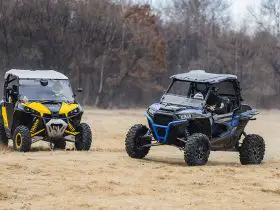Utility Terrain Vehicles, or UTVs, are four-wheel vehicles that are similar to ATVs but typically seat two or more riders, have a roll cage, and have a small bed in the back for gear. They’ve carved a place in the off-road industry for themselves by being just as rugged as an ATV, but with the ability to carry more people and cargo. You can even make them legal to drive on public roads.
Whether a UTV can be legally driven on the street depends on the state of operation. However, almost half of states have rules that allow the use of UTVs on public roads, at least in some instances. An off-the-shelf UTV will need some modifications made to it, in order to be legal to drive on the road.
It can be relatively simple and surprisingly affordable to street legalize a UTV. You may wonder why you might want to do so, but then you can consider that many great off-road trails are often joined by public roads. If you could drive your UTV on the road, you wouldn’t have to trailer it. This article will help you make your UTV legal to drive on the road.
Table of Contents
How to Make a UTV Street Legal
If you’re thinking of trying to make your utility terrain vehicle street legal, you’ll need to make a few modifications to it. Unless your vehicle is street legal from the manufacturer, side-by-sides are often not street legal when purchased new from the store.
The specifics to make UTVs street legal vary by state (more on that below), but any vehicle driven on the street generally needs the following features:
- Turn signals
- Horn
- License bracket and plates
- Registration and insurance
Again, many states vary in what exactly they require in order for a UTV to be street legal, and many of them also restrict where UTVs can be ridden (Nevada, for instance, only allows UTVs to be ridden on roads where the speed limit is 45 mph or lower). The question of whether your UTV can be street legal really depends on where you live and intend to ride it.
If you have a UTV and you’re looking for how to make it legal to take on the road in your state, you’ve come to the right place. Let’s explore how exactly you can go about making your UTV street legal no matter where you are.
Pros and Cons of a Street Legal UTV
We’ll dive into these pros and cons a little farther below, but here’s a summary of the reasons for and against making a UTV legal to drive on the road:
| Pros | Cons |
| Save money on a trailer and truck | Added expense in installing the kit |
| Save time while off-roading between trails | Licensing and registration fees can add up |
| Convenient and saves on gas when driving around town | Have to keep your UTV to a higher standard of safety and maintenance |
| More expensive insurance |
Pros of a Street Legal UTV
Before going through the hassle of making your UTV legal to drive in the street, you might be wondering why exactly you’d want to do so. A UTV can be expensive enough, but if it’s not able to drive on the street, you’ll also have to invest in a trailer and a towing vehicle. This can get expensive, but if you could drive your UTV on the road, you can save some money.
Apart from saving money, you’ll also be saving time and making your off-roading more convenient. Many off-road trails in remote areas are connected by public roads, and if your UTV isn’t street legal, you’ll have to trailer it before moving on to the next trail. If you can take your UTV on the road, however, you can keep the fun going all day.
Finally, a street legal UTV can be nice in small towns or neighborhoods where they allow golf carts and similar types of vehicles to drive around. In nice weather, you’ll have the option to drive around town in your open-door UTV for fun, without having to use up the fuel in your more conventional vehicles. Have in mind that people around you would appreciate if your UTV is somehow a bit quiet.
Cons of a Street Legal UTV
You might not need to make your UTV street legal in certain circumstances. If you’re not in an area where you’re likely to use it on the road, for instance, it’s probably not going to be worth the added expense. Some kits may cost as little as a couple hundred dollars, but it’s wasted money if you have no intention of using it.
You also will have to worry about registering your vehicle, which is another expense. These fees and expenses can really add up, especially in certain states. Again, this is an instance where you may not find it to be worth it to drive your UTV on the street. You’ll also have to pay for insurance for a road-worthy vehicle, which is more expensive.
Finally, a street-legal UTV has to be better maintained than a UTV that’s just driven off-road. Being on the road means it’s likely subject to higher standards for inspections and safety; things you might not have to worry about if you’re just taking it through some backwoods trails.
UTV Street Legal Kits
The specific rules and regulations for street legal UTVs vary from state to state in the United States, but luckily, you can purchase street legal kits that are custom designed for whatever state you’re in. Here’s a great guide for the applicable laws in your state, but generally speaking, any kit to make your UTV street legal will have the following components:
- Turn signal kit
- Horn
- Department of Transportation approved tires
- Rear-view/side-view mirrors
- Headlights
- Brake lights
- Windshield
Some of these items may be required for your state, and some may not. There are a variety of vendors that can sell customized street legal kits for your UTV, and most of them are easy enough that you can do the additions yourself.
How to Determine Your State’s Laws
There are a few different places you’ll have to go to get an up-to-date answer on whether you can legally drive your UTV on the street in your state. These places can include:
- Your local DMV office
- Your county/city
- Your local Forest Service
- Online social media UTV enthusiasts’ groups
States Where UTVs Can be Driven on the Road
Here’s a brief list of the states that allow UTVs to be driven on the road, in one form or another. Many of these states restrict usage to certain roads, they require installation of certain extra components, or they just leave the decision up to individual cities or counties.
- Alabama
- Arizona
- Arkansas
- California
- Colorado
- Connecticut
- Florida
- Georgia
- Hawaii
- Idaho
- Kansas
- Maine
- Minnesota
- Missouri
- Montana
- Ohio
- Oklahoma
- Oregon
- Pennsylvania
- South Carolina
- South Dakota
- Utah
- Vermont
- Washington
Again, these regulations can change at any time, and many of these states are very strict in their rules. Make sure you cover all your bases and do your own research before you start spending any money on making your UTV legal to drive on public roads.
Final Thoughts
UTVs can be a lot of fun, and they can be a convenient way to get around where they’re allowed. They’re relatively simple to make street legal, but the requirements for doing so can vary greatly from state to state. Many states don’t allow any UTVs on public roads, still others allow them under only limited circumstances, and others leave it up to the individual counties.
If you want to make your UTV street legal, make sure you do your research and see if it’s even allowed in your state, then find out the necessary features that need to be added to your vehicle. You can find kits that are customizable for almost any state’s requirements. If you can swing it, making your UTV street legal can be a great way to enjoy it even more!








